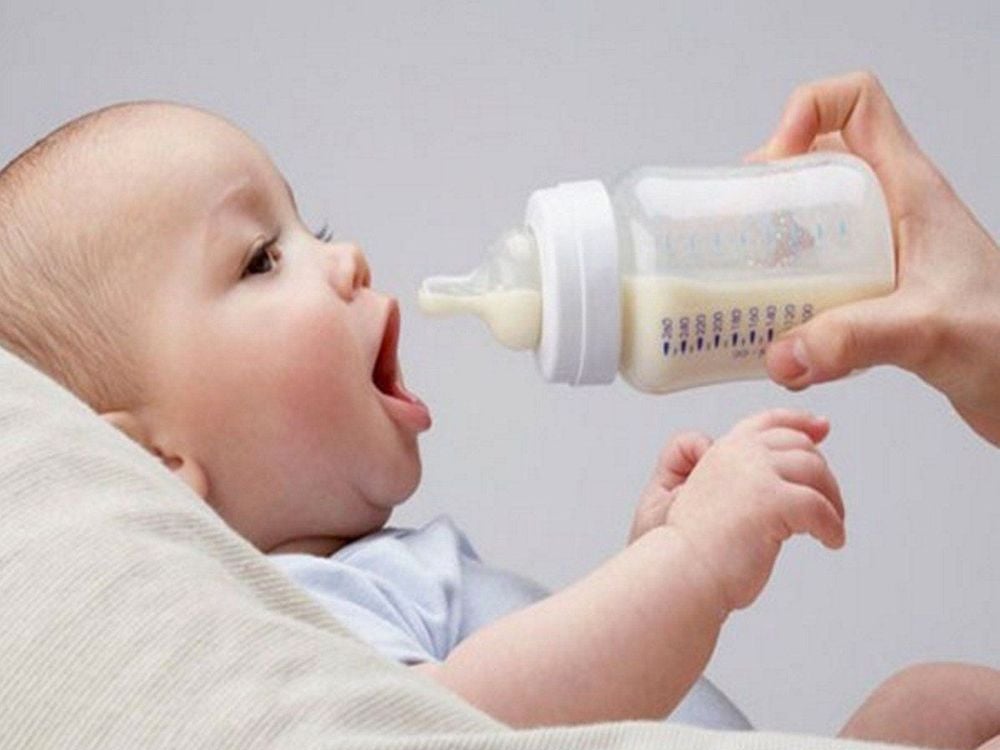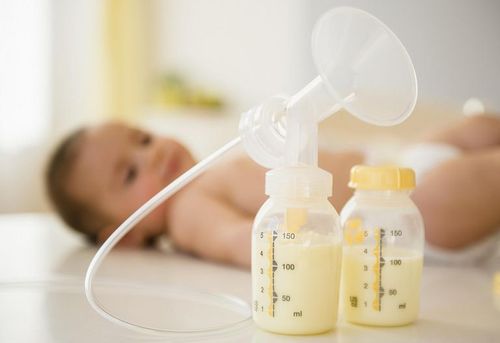This is an automatically translated article.
The article was professionally consulted by Specialist Doctor II Cao Thi Thanh - Pediatrician - Pediatrics - Neonatology Department - Vinmec Hai Phong International General HospitalThe transition from breastfeeding to regular feeding can be uncomfortable for babies because the nipples are not the same. Many children even react very violently, crying or skipping meals. So how to practice effective bottle feeding for children without affecting their health and mental well-being?
1. Why should mothers practice bottle feeding?
Some mothers breastfeed for the first few months, but due to work and family circumstances... it becomes difficult to arrange a time for direct breastfeeding. So, one can think of “partial” breastfeeding weaning, which means reducing the number of direct breastfeeding sessions and replacing it with bottle feedings – but also expressed breast milk.For some personal reasons, some mothers feel like they want to stop breastfeeding completely, and switch to formula milk, or pasteurized fresh milk (after 1 year of age) for babies by training bottle-fed babies. This is not an ideal choice for babies, especially in the first 6 months - 1 year of a child's life, because at this time breast milk is still a source of nutrition with outstanding value and properties that protect development, increase growth. optimal growth of the baby's organ systems.
Whether it's partial or full weaning, it's important not to do it too quickly and suddenly. Instead, weaning off breastfeeding should be planned slowly, over a period of several weeks or months, as the case may be.
Trắc nghiệm: các chỉ số cần chú ý về sự phát triển thể chất của trẻ
Chiều cao, cân nặng của bé ở từng giai đoạn nên là bao nhiêu là bình thường, bao nhiêu là bất thường? Cùng ThS.BS Ma Văn Thấm điểm lại xem bạn đã nắm được các chỉ số phát triển thể chất của bé chưa nhé!The following content is prepared under supervision of Thạc sĩ, Bác sĩ y khoa, Ma Văn Thấm , Nhi , Phòng khám Đa khoa Quốc tế Vinmec Dương Đông(Phú Quốc)
Babies born prematurely, smaller for their gestational age, or unwell in the neonatal period may need to be bottle-fed for a short time while breast-feeding is not yet possible. . Babies with low blood sugar may also need to be bottle-fed if their meal needs extra calories. Sometimes, because the mother has not yet produced milk, the bottle will help the baby overcome hunger. If your baby is losing weight, bottle feeding may be essential. Babies with cleft lip or palate, difficulty swallowing or breathing, and problems with sucking/swallowing reflexes can also be bottle-fed.

2. Guide to bottle feeding for babies
When babies are used to breast milk and start to switch to bottles, mothers need to gradually get used to the new milk and new ways of feeding - not the breast.Because the baby is used to sucking at the breast, when switching to bottle feeding, he must practice gradually from less to more and need to coordinate with breast milk, but the amount of milk, the number of meals... depends on the baby's age. The average amount of milk needed for babies is 50ml/kg/day (including breast milk and formula milk). The amount of milk is divided into 8 meals, feeding every 3 hours. Children 6 months of age reduce nighttime feeding and by 9 months, cut off night meals altogether. For children under 6 months can give 700ml to 800ml per day. Children over 6 months can give 600-700 ml per day. In order to get used to the baby's first time getting used to bottle feeding (it can be from 3 days to 5 days depending on the adaptability of each baby), mothers need to express their milk into a feeding bottle for the baby to get used to it. with bottle feeding. When the baby is used to bottle feeding, breast milk will gradually be converted to formula milk (boxed milk) mixed according to the instructions and put into the bottle for the baby (milk volume from 60ml gradually increases to 80ml and then 100ml). In case the mother's health is normal, it is possible for the baby to practice bottle-feeding in parallel with breast-feeding until the baby is 24 months old. From 7 months to 24 months need 400ml - 500ml of formula (if breastfeeding) and 600ml - 700ml if no longer breastfeeding. Children over 24 months who no longer breastfeed need 600ml - 700ml per day. Children under 6 months divided into 8 meals per day. From 6 months to under 9 months reduce to 6 meals per day and from 9 months onwards reduce to 4 meals per day (morning - noon - afternoon - evening). After switching from breast milk to bottle, if possible, it is best to practice feeding from a cup because it is easier to clean than bottle feeding.
3. Notes when practicing bottle feeding for babies
It is rare for children to be bottle-fed right from the beginning, so it is not unusual for the baby to refuse to take the bottle at first, don't force the baby at first, but be persistent and decisive.
Mothers can find pacifiers like bottle nipples for baby to contact and practice first.
It's better for other people to practice bottle-feeding than the mother, she should not be around if possible, sometimes she has to change rooms when bottle-feeding, not mentioning her mother when others practice bottle-feeding.
Babies are rarely bottle-fed at night, so practice during the day and at a comfortable time.
Distraction when practicing: let the baby turn outside to look around, not towards the mother and then practice.
If the mother decides to wean her baby and replace it with a bottle, she should choose the nipple with the smallest outlet, so that the milk flow is slow, the baby will be more accepting. If the nipple outlet hole is too large, the milk flow is fast and continuous, which can cause the baby to "flood" because he is used to the slow milk flow of the mother's breast. As a result, the baby may be upset and refuse to take the bottle.
When starting to wean a baby from breast milk and transitioning to formula, it is advisable to choose the milk with the most similar taste to breast milk because breast milk is initially received by the baby and will remember this taste.
Bottle of milk should be warm. Many breastfed babies prefer milk that is warmer than normal temperature. Of course, it's not about heating to the point of burning your child.
For children to be healthy and develop well, it is necessary to have a nutritious diet in terms of quantity and quality balance. If children are not provided with adequate and balanced nutrients, it will lead to diseases of excess or lack of nutrients, which adversely affect the comprehensive development of children in terms of physical, mental and motor skills.
Parents should supplement their children with supportive products containing lysine, essential micro-minerals and vitamins such as zinc, chromium, selenium, and B vitamins to help fully meet their child's nutritional needs. At the same time, these essential vitamins also support digestion, enhance nutrient absorption, help improve anorexia, and help children eat well.
Parents can learn more:
Signs of zinc deficiency in children
Micronutrient deficiency and failure to gain weight in children
Please regularly visit Vinmec.com website and update useful information to take care of your child. Take care of the baby and the whole family.















